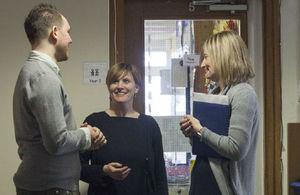Academy saves £800,000 and improves student outcomes
Thomas Deacon Academy addressed financial difficulties by consulting with staff and unions to cut costs while still improving outcomes.

The challenge
Thomas Deacon Academy (TDA) in Peterborough is a specialist mathematics and science college that opened as an academy in 2007. It is much larger than the average-sized secondary school. Perkins Engines and the Deacon’s School Trust sponsor the academy.
When Julie Taylor, CEO and principal, started working at TDA in September 2013, it was facing significant financial difficulties. The academy was forecasting an in-year deficit of £650,000 in the academic year 2014 to 2015. The projected deficit showed a year-on-year increase over a 5-year period to £2.3 million in the 2018 to 2019 academic year. The academy also suffered from poor academic results. In July 2013, an Ofsted inspection rated the academy as ‘requires improvement’. The following year the results did not meet the government’s floor standards.
The change process
To address the financial situation, Julie started by looking at what efficiency savings she could make from non-pay costs. She also looked at staff pay which formed 88% of the general annual grant (GAG). Projections indicated that this would increase to more than 100% by the 2018 to 2019 academic year. Julie reviewed the staffing structure with a view to reducing the proportion of GAG spent on pay costs. Right from the start, she recognised that extensive consultation with staff and unions was essential before making any changes to staffing structures.
In May 2014, Julie began gathering relevant information. She held initial discussions and developed proposals for a revised staffing structure. One of her key priorities was to make staff savings while protecting pupil outcomes. Another was to consult all relevant parties on the changes and keep them informed as plans progressed.
Julie followed a completely transparent process with unions, colleagues, students, parents and the community. To keep all parties informed of the changes, Julie posted 2 videos on the academy’s website to explain why she was undertaking the reorganisation: one at the beginning; and one at the end of the process. She also invited the local media in and took a centre-page spread in the local newspaper. She had an open door policy for all staff. She also published and updated everything on a weekly basis in the shared area on the academy’s network.
As part of her engagement, Julie also sought feedback on the proposed changes and adjusted her plans accordingly. She met weekly with the unions. This ensured that they had several opportunities to comment on the plans as they developed. Julie also produced a business case on which she invited feedback as part of a formal consultation process. Following suggestions put forward by the unions, Julie made 22 amendments to the business case. Julie also engaged solicitors to support staff in getting impartial advice and guidance.
The outcome
The senior leadership level underwent the most changes as a result of the restructuring. It reduced from 8 college leaders to 4 deputy-vice principals. The organisation was re-distributed with a simpler middle leadership structure. Adhering to the principles of teaching and learning responsibility (TLR) payments meant that each middle leader had to have at least 4 people to manage. As a result, some middle leaders managed a combination of subjects, especially where a subject had only 1 or 2 teachers.
TDA managed to avoid large scale redundancies. Out of 38 teaching posts ‘at risk’ from the re-organisation, there were only 5 compulsory redundancies. Natural turnover accounted for most of the necessary teaching post reductions. There were also 8 voluntary redundancies. Similarly, out of 19 associate posts ‘at risk’, there were only 2 compulsory redundancies. Eight associates resigned and 9 took voluntary redundancy.
Julie also considered reducing planning preparation and assessment (PPA) time from 20% to 10%. However, she rejected this so that staff could focus on improving pupil outcomes.
Financial efficiency achievements
Restructuring TDA achieved savings of £800,000. As a result, the academy has now set a balanced budget. Pay costs in the 2015 to 2016 academic year were on budget and £346,000 below the previous year’s level. Pay as a percentage of income was 73% (target 76%) in the 2015 to 2016 academic year and as a percentage of GAG it was 81% (target 82%). At the same time, outcomes for students have improved and in July 2015 Ofsted rated TDA as ‘good’.
CEO looks back at the process
Reflecting on the overall process, Julie Taylor states that:
“The seriousness of the financial situation meant that bold action was necessary. By making strategic choices focusing on student outcomes, we managed to put the academy on a secure financial footing while at the same time improving outcomes. Following a transparent process, and consulting on the changes with all relevant parties, helped us keep unions, staff, parents and students on board.
“We faced some very difficult choices over the last few years but, as a result, we have secured the future of the academy for the benefit of the children, parents and staff.”
If you would like to find out more, you can contact Julie Taylor.